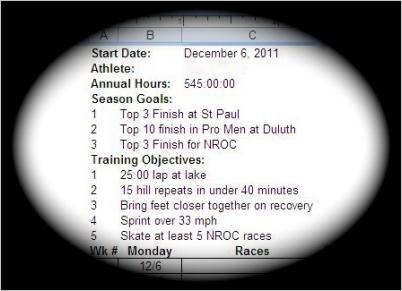This week's tip:
Create Your Training Plan
Step 1: Set your goals
By Alex Fedak

Setting your goals.
Inline skating is so enjoyable that it is easy to go out and hammer every day. And that’s fine. Skating regularly is a great way to keep in shape.
But if you have specific goals — like improving your cruising speed or winning your division in a marathon or losing 20 pounds — you have to do more than just go out and hammer.
You have to have a plan — specifically, a training plan.
Training plans are road maps that help you get from Point A, where you are now, to Point B, where you want to go.
They focus your training. Without a training plan, you are basically adrift with no real direction forward. With a training plan, you are headed somewhere — and if your plan is well designed, you will find yourself taking giant steps in the right direction.
Ready to get started?
Good! It’s relatively easy — and even fun — to create a training plan. Just follow these steps and you’ll be rolling toward your goals in no time:
1) Set your goals.
The first thing you have to do is decide what it is you want to accomplish or achieve. Do you want to win your age division in an inline marathon? … Increase your average cruising speed to 18 mph? … Lose 20 pounds? … Or, like me, get into peak condition just in time for one or more important races next year.
Pick one or more goals. But be realistic. Don’t decide to scale Mt. Everest next year if you currently huff and puff climbing a flight of stairs.
If your goals are too lofty, you are liable to fail. And failure — especially repeated failure — can be toxic. It can discourage you and might cause you to quit training all together.
If you are not sure about how high to set your goals, do a self-assessment. If your goal is to skate faster, use a stopwatch of GPS to determine how fast you are now. If you want to improve your marathon times, review your previous performances. If you want to lose weight, get on a scale.
Then set your goal up to the next level. For instance, if you skated a marathon in 2 hours this season, set your goal to skate the marathon in 1 hour and 45 minutes next season.
That’s a significant improvement, one you can be proud of. And if you achieve it, you can then set the bar higher.
After you figure out what your goals are, write them down. Many athletes use a training journal for this. Writing your goals makes them concrete and real.
Then take a good look at them. Can you live with them? Do they feel right? They should. But don’t worry. You can always revise them as you go along.
The important thing is to set goals that move you in the right direction.
---
Step 2: Figure out what to do
...
 Alex Fedak is one of America’s top pro skaters. In recent years, he has notched top five finishes in Saint Paul, Ottawa, Houston, San Diego and Round Rock. He is also a Category 3 road cyclist and an accountant for Oklahoma City. “I have been skating since I was very young, starting on quads and then transitioned to inlines in the early 90’s,” he says. “My first inline race was in 2003 at a local Oklahoma City event. Then I branched out to Texas. Since then, I have averaged five to seven inline races a year.” A member of Simmons Racing, he trains with hometown buddy and teammate Rob Bell.
Alex Fedak is one of America’s top pro skaters. In recent years, he has notched top five finishes in Saint Paul, Ottawa, Houston, San Diego and Round Rock. He is also a Category 3 road cyclist and an accountant for Oklahoma City. “I have been skating since I was very young, starting on quads and then transitioned to inlines in the early 90’s,” he says. “My first inline race was in 2003 at a local Oklahoma City event. Then I branched out to Texas. Since then, I have averaged five to seven inline races a year.” A member of Simmons Racing, he trains with hometown buddy and teammate Rob Bell.